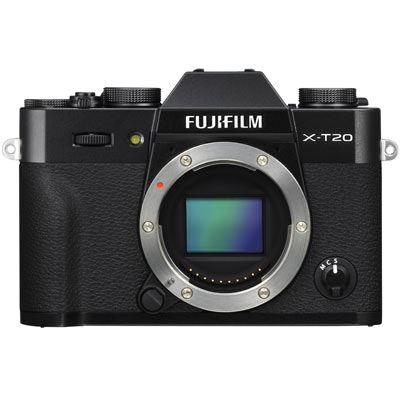Share your photographs...
We would love to feature your photographs on our equipment pages to help inspire others. We respect your copyright. Sharing is easy, just send us a link to your image on social media or your own website and remember to tell us about the following:
State that you own the copyright
Give us permission to use it
Include a link to your your web space
Include a caption for the image
Tell us about the equipment used

Upload date: 2018-02-20 Caption: Fujifilm X-T20 Camera sample photograph, © Norifumi Inagaki
Review this item...
Tell us how you would rate it overall:
There are no reviews for this item
24.3MP APS-C X-Trans CMOS III Sensor
Utilizing Fujifilm's unique, randomized pixel array, the 24.3MP APS-C X-Trans CMOS III sensor affords a high degree of image quality and sharpness due to the omission of an optical low-pass filter. Versus conventional pixel patterns, the X-Trans design more closely mimics the organic nature of film in order to produce nuanced colors and smooth tonal transitions, while also reducing moiré and aliasing.
X-Processor Pro
Aside from benefitting the low-light performance with an expandable sensitivity range to ISO 51200, the X-Processor Pro also contributes to fast performance throughout the camera system, including a start-up time of 0.4 seconds, shutter lag time of 0.05 seconds, shooting interval time of 0.25 seconds, and a continuous shoot rate of 14 fps when working with an electronic shutter, or 8 fps with a mechanical shutter.
UHD 4K and Full HD Video
Accessible via the drive dial on the top plate, the X-T20 supports both recording in both UHD 4K/30p and Full HD 1080/60p resolutions. Film Simulation modes can be used during recording to give a distinct look to footage, and video can also be output via HDMI to an external recorder or monitor, and a mic jack is featured for working with an external microphone.
Body Design
The rear 3.0" 1.04m-dot LCD touchscreen allows for intuitive operation, focus point selection, and menu navigation, and its tilting design benefits working from high and low angles.
High-resolution 2.36m-dot electronic viewfinder allows for bright, clear eye-level monitoring with a frame rate of 54.54 fps for smooth monitoring in a range of lighting conditions.
Dedicated shutter speed, drive mode, and exposure compensation dials for direct, intuitive control over exposure and shooting settings.
The physical exposure compensation dial now features a C position to permit an expanded +/- 5 EV range when working with the control dials.
Built-in Wi-Fi allows for direct wireless sharing of files as well as remote camera control from a linked mobile device.
Built-in pop-up flash is available for additional illumination, and a hot shoe is featured for working with an optional external flash.
91-Point Autofocus System
Utilizing both contrast- and phase-detection methods, the hybrid autofocus system employs 91 total points, which can be divided into 325 total areas for a high degree of focusing accuracy in a variety of lighting conditions. Approximately 50% side-to-side and 75% top-to-bottom of the frame is covered by phase-detection points in order to provide fast AF performance to suit working with moving subjects.
When working with autofocus, you can choose either single-shot AF-S mode or continuous AF-C mode, and each can be used in conjunction with Single Point AF, Zone AF, or Wide/Tracking AF settings. Additionally, AF-C Custom Settings let you choose from five AF-C presets depending on how your subject is moving, and the AF algorithm has been optimized for improved subject tracking and overall accuracy.
Film Simulation Modes
Taking advantage of Fujifilm's vast history in traditional film-based photography, the X-T20 integrates several Film Simulation modes, which can be used for photos or videos, to mimic the look and feel of some of Fujifilm's classic film types. A refined Classic Chrome mode is designed to deliver muted tones and a deep color reproduction, similar to that of a dated slide film. Pulling from their more contemporary line of transparency films, Provia offers natural-looking tones for everyday shooting, Velvia produces a more dramatic and rich tonality with deeper color saturation, and Astia gives less contrast for a softer depiction of skin tones. Mimicking their negative films, Pro Neg. Std. gives smooth image tones that are suitable for accurate color renditions, while Pro Neg. Hi produces a more dramatic feel with the ability to draw color out of a variety of lighting conditions. In addition to the colorful benefits of these Film Simulation modes, there are also monochrome modes that simulate the look of traditional yellow, green, and red black and white contrast filters, as well as an Acros mode that can also be paired with colored filter effects. A sepia mode is also available for producing an inherently nostalgic look.
Other Camera Features
Advanced SR Auto mode can be used for fully automatic shooting with scene recognition to permit on-the-fly shooting in a variety of settings.
Interval Timer shooting lets you record an infinite number of consecutive frames with 1 second to 24 hour intervals, and a 1 minute to 24 hour starting delay.
Multiple Exposure mode lets you shoot two consecutive overlaid frames, and the first frame will be shown on the rear LCD to aid in alignment for the second exposure.
In-camera 180° panoramas can be shot by simply panning the camera about the scene.
Advanced Filters: Toy Camera, Dynamic Tone, Miniature, High Key, Soft Focus, Pop Color, Low Key, and Partial Color (Red, Orange, Yellow, Green, Blue, and Purp
| Attribute | Value |
|---|---|
| AEB (Bracketing): | (3 frames at 1/3 EV, 2/3 EV, 1 EV steps) |
| Aspect Ratio: | 1:1, 3:2, 16:9 |
| Autofocus Points: | 91 |
| Autofocus System: | Contrast Detect (sensor), Phase Detect, Multi-area, Center, Selective single-point, Tracking, Single, Continuous, Touch, Face Detection, Live View |
| Battery Model: | NP-W126S |
| Connectivity: | USB 2.0 (480 Mbit/sec), HDMI Micro (Type D), Built-In Wireless, 802.11b/g/n, Remote control via smartphone, cable release |
| Diopter Adjustment: | 2 to +1m-1[dpt] |
| Exposure Compensation: | ±3 stops in 1/3 steps |
| File Formats: | RAW/JPEG |
| Flash Type: | Built in |
| Frames Per Second: | 8 |
| Image Processor: | X-Processor Pro2 |
| Included Accessories: | Li-ion battery NP-W126S, Battery charger BC-W126, Shoulder strap, Lens cap, Metal strap clip, Protective cover, Clip attaching tool, USB cable, Owner,s manual |
| ISO Maximum: | 51200 |
| ISO Minimum: | 100 |
| Lens Mount: | Fuji X |
| Maximum Resolution: | 6000 x 4000 |
| Megapixels: | 24.3 |
| Memory Card Format: | SD Card /SDHC Card / SDXC Card / UHS-I*1 |
| Metering System: | Multi, Center-weighted, Average, Spot |
| Plug Type: | 0 |
| Raw Buffer Depth: | 8 |
| Screen Resolution (Pixels): | 1040000 |
| Screen Size (Inches): | 3 |
| Sensor Format: | APS-C |
| Sensor Size: | 23.6mm x 15.6mm |
| Sensor Type: | X-Trans CMOS III |
| Shutter Speed, Maximum: | 1/32000 sec |
| Shutter Speed, Minimum: | 30sec |
| Size (mm): | 118.4mm [W] x 82.8mm [H] x 41.4mm |
| View Finder Coverage: | 100% |
| Viewfinder: | OLED |
| Weight (g): | 370 |
| HD Movie Mode: | 4K, 3840 x 2160 (29.97p, 25p, 24p, 23.98p), 1920 x 1080 (59.94p, 50p, 29.97p, 25p, 24p, 23.98p), 1280 x 720 (60p, 50p, 30p, 25p, 24p) |










